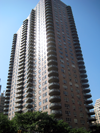 The Building Code changes require fire sprinklers in multiple-unit residential buildings higher than three storeys. The changes come into effect on April 1, 2010.
The Building Code changes require fire sprinklers in multiple-unit residential buildings higher than three storeys. The changes come into effect on April 1, 2010.The new requirements apply to new construction, additions to existing buildings, floors of existing buildings that undergo a change of major occupancy, and floor areas that undergo extensive (“gut”) renovation. Sprinkler requirements apply throughout the building, including residential suites, service areas and common areas, such as corridors.
The new requirements also cover the residential portions of mixed-use buildings higher than three storeys.
The new requirements do not apply to smaller residential buildings, including houses, or to the renovation of portions of floors. Certain forms of four-storey stacked townhouses having specific fire safety features, such as independent exits, are also exempt.
The Building Code does not mandate the retrofit of existing buildings where no construction is proposed.
The changes replace some Building Code requirements that acted as alternatives to sprinklering. However, the Code amendments also specify that unsprinklered buildings undergoing renovation will still have to meet current Ontario specific requirements, unless the renovated area is sprinklered.
The changes also increase the maximum size of live-work units from 150m2 to 200m2.
The Ministry of Municipal Affairs and Housing intends to work with the building sector to review potential Building Code changes that could increase design flexibility and reduce costs, while maintaining high standards of safety.
Reference: Ontario Building Code Act 1992, Article obtained from mah.gov.on.ca